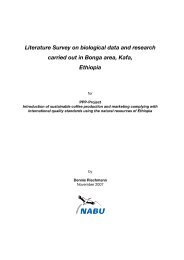Flora Biodiversity Assessment in Bonga, Boginda and Mankira Forest
Flora Biodiversity Assessment in Bonga, Boginda and Mankira Forest
Flora Biodiversity Assessment in Bonga, Boginda and Mankira Forest
You also want an ePaper? Increase the reach of your titles
YUMPU automatically turns print PDFs into web optimized ePapers that Google loves.
Assefa <strong>in</strong> IBC, 2002 made an assessment of Bog<strong>in</strong>da forest (Kaffa). In their assessment,<br />
they came up with 479 stems per hectare (dbh 10 cm <strong>and</strong> above).<br />
Ensermu Kelbessa <strong>and</strong> Teshome Soromessa, 2004 recorded 57 woody species for <strong>Bonga</strong><br />
forest. In moist tropical undisturbed forest (exclud<strong>in</strong>g herbs <strong>and</strong> grasses) about 746 trees<br />
per ha <strong>and</strong> 65 tree species were recorded (Bokor, 1979 cited <strong>in</strong> Lamprecht, 1989). In<br />
<strong>Bonga</strong>, Bog<strong>in</strong>da <strong>and</strong> <strong>Mankira</strong> the number of species recorded <strong>in</strong> the current survey,<br />
<strong>in</strong>clud<strong>in</strong>g regeneration <strong>and</strong> sapl<strong>in</strong>gs are 89, 74 <strong>and</strong> 66, respectively.<br />
In the current survey the density of woody species (<strong>in</strong>clud<strong>in</strong>g regeneration <strong>and</strong> sapl<strong>in</strong>g) <strong>in</strong><br />
<strong>Bonga</strong>, Bog<strong>in</strong>da <strong>and</strong> <strong>Mankira</strong> is 142464, 46135 <strong>and</strong> 68500, respectively. The highest<br />
woody species <strong>in</strong> <strong>Bonga</strong> is Maytenus ovatus (62500). Whereas <strong>in</strong> Bog<strong>in</strong>da <strong>and</strong> <strong>Mankira</strong><br />
Justica schimperiana <strong>and</strong> Dracaena fragrance are the highest woody species recorded.<br />
Coffea arabica <strong>in</strong> <strong>Bonga</strong> is the 5 th highest recorded (3316). In Bog<strong>in</strong>da it is the 6 th<br />
abundant species (2220). However, <strong>in</strong> <strong>Mankira</strong> it is the 2 nd highest recorded woody<br />
species (6340).<br />
It is possible to conclude that the result of the current study is comparable with<br />
aforementioned studies. However, there are few variations e.g., between Ensermu<br />
Kelbessa <strong>and</strong> Teshome Soromessa, 2004 versus the current f<strong>in</strong>d<strong>in</strong>gs on the number of<br />
species; <strong>and</strong> density of trees estimated by Lamprecht, 1989 versus the current study. In<br />
the current study wider area is accounted especially <strong>in</strong> terms of altitud<strong>in</strong>al range <strong>and</strong> more<br />
sample plots are taken than Ensermu Kelbessa <strong>and</strong> Teshome Soromessa, 2004. As it is<br />
mentioned under section 4.3 above logg<strong>in</strong>g practice has been conducted with<strong>in</strong> Kaffa<br />
forest. It might be the reason for the current lower number of stems per ha than the<br />
estimate made by Lamprecht,1989.<br />
4.3.3 Regeneration per hectare<br />
Lamprecht, 1989 referr<strong>in</strong>g Bokor, 1979 <strong>in</strong>dicated that on average 72,000 seedl<strong>in</strong>gs per ha<br />
(maximum 124,000) between 0.3 <strong>and</strong> 1.3 meter <strong>in</strong> height are recorded <strong>in</strong> tropical moist<br />
forest. In <strong>Bonga</strong>, Bog<strong>in</strong>da <strong>and</strong> <strong>Mankira</strong> on average 137,546, 34,417 <strong>and</strong> 55,250<br />
regenerations are estimated, respectively. Getachew Berhane <strong>and</strong> Yoseph Assefa <strong>in</strong> IBC,<br />
47



